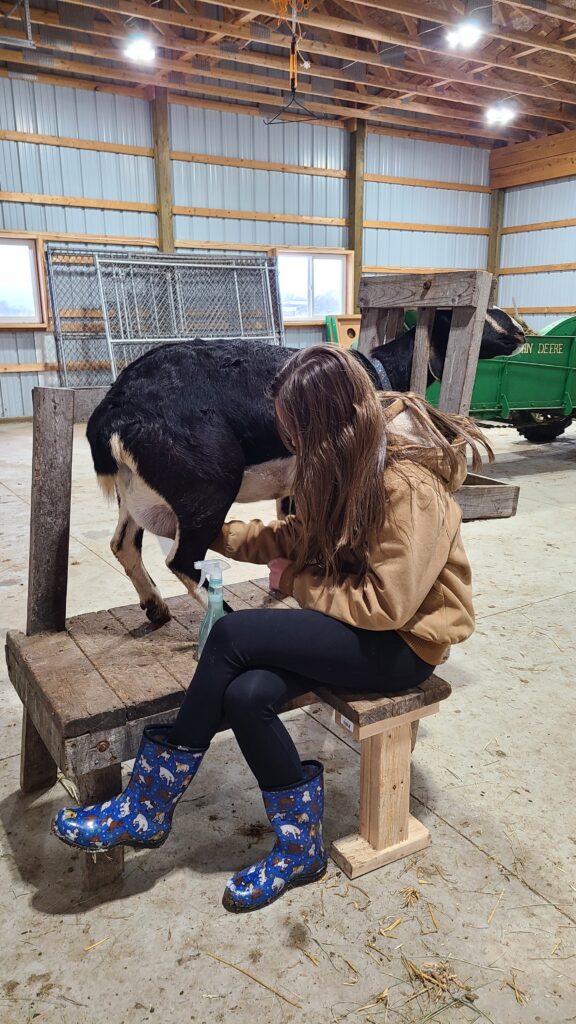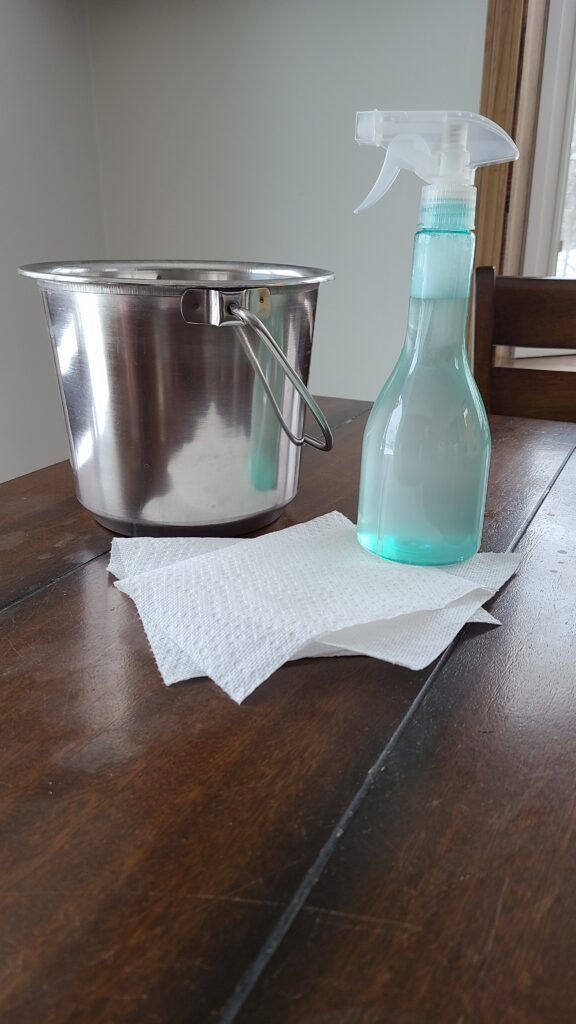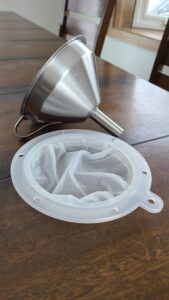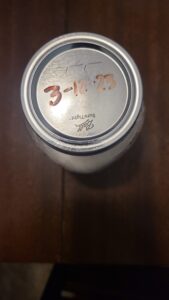If you are milking goats for the first time or are just looking for ways to minimize waste in your normal milking routine, here are the six items I highly recommend you have on hand. Having the proper milking equipment is essential to a successful home dairy experience. These six must-have milking items will make milking your goat safe, quick, and enjoyable.

This post contains affiliate links. As an Amazon Associate, I earn from qualifying purchases.
I love having dairy goats and being able to provide my family with wholesome, raw milk. Since I only milk between 1 and 5 does daily, I have not invested in a milking machine. I don’t think it would save me much time and there would be a lot more complex equipment to maintain and clean. Further, I think I would miss the time I get to spend with each of my girls during milking.
To make your hand-milking experience a positive one, here are 6 essential items I recommend using, and personally use, every time I milk.
1. Milking stand

A sturdy milking stand is a must-have. I prefer one that has a feeder attached, I feed my does while I am milking and it helps to keep them occupied and still.
The stanchion has a bolt to secure the goat’s head so they are locked in and then released once milking is complete.
My stand has a crossbar support on the side opposite my seat. This gives the goat a boundary so they are less likely to step off with their rear legs during milking and hurt themselves.
Milking off the ground is more sanitary and ergonomic as well.
Goats are easy to train, a few days of giving your doe grain in the stand will make her eager to jump up and await her next meal. For more tips on training a goat to be milked, click here to read my other article.
2. Teat wash

Another item you need for hand-milking is something to wash and dry the teats and udder with. Skipping this step will lead to more hair, dirt, debris, and bacterial contamination of your milk- which you do not want!
I make my own spray with essential oils for cleaning the udder before milking. You can find my recipe for udder wash here. Prior to that, I used a wet paper towel with a drop of Dawn dish soap. There are lots of store-bought options to choose from as well. Take your pick, just remember to give the udder, and especially the teats, a wipe down before you start milking.
It is important to dry the teats off after cleaning them. Washing without drying can leave the teats chapped and sore. I use paper towel, but a clean cloth is another option.
3. Stripping cup

Once you have your doe in the stand and have cleaned her off, its time to milk! Milk the first few squirts into a stripping cup.
One of the reasons for doing this is to remove the wax plugs and any remaining contaminants from the teat orifice before collecting the milk for consumption. Another reason I use a stripping cup is so that I stop and inspect the milk before I combine it with milk from other does. There have been times that I noticed the color or texture of the milk being off from the stripping cup and then kept the milk separate.
I give the stripped milk to my barn cats or dogs, and they love it!
4. Milk bucket with lid

For collecting and holding milk for human consumption you will want to use a stainless steel pail. I found one with a lid that helps keep dust and hungry cats out.
After use, wash it thoroughly with soap, rinse it with hot water, and let it air dry. It is very important to keep your milking equipment clean!
5. Straining equipment

After I finish milking I take the milk right into the house, strain it, and then put it in the refrigerator. I have found that my milk tastes best when it is chilled quickly.
I use a 5.1-inch stainless-steel, food grade straining funnel with a washable 200 mesh filter inside. This works way better than a coffee filter, cheese cloth, or other strainers that I have tried in the past! There is no wait time and no waste of milk with this filtering system.
I strain only one time so I put my storage jar right underneath the strainer. When I am done straining the milk, I wash the funnel and mesh filter with soap and water and let them air dry. Every once in a while, I put them in the top rack of my dishwasher and they do fine.
I have used the same stainless-steel funnel for years, but about once a year I have to order a replacement 200 mesh filter because it starts coming off the plastic ring.
6. Storage jars

In my opinion, raw goat’s milk tastes and keeps best in glass jars. I love my tall 2-quart jars, but regular Mason jars work too.
I use a dry-erase marker to note the date of collection on the lid.
Non-essential Items for Hand-Milking Dairy Goats
There are lots of extras you can use if you want to get fancy milking your goats. If you want to track production you will need to add a record keeping system (paper or online) and a scale for weighing the milk to your armamentarium.
Is there a milking item you can’t live without that we don’t have on our list? Tell us about it in the comments below.

Mother, farmer, author, and teacher by trade… She loves tending to things and watching them grow!
